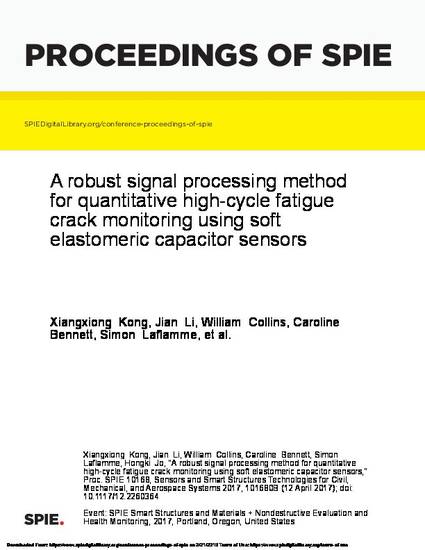
A large-area electronics (LAE) strain sensor, termed soft elastomeric capacitor (SEC), has shown great promise in fatigue crack monitoring. The SEC is able to monitor strain changes over a mesoscale structural surface and endure large deformations without being damaged under cracking. Previous tests verified that the SEC is able to detect, localize, and monitor fatigue crack activities under low-cycle fatigue loading. In this paper, to examine the SEC’s capability of monitoring high-cycle fatigue cracks, a compact specimen is tested under cyclic tension, designed to ensure realistic crack opening sizes representative of those in real steel bridges. To overcome the difficulty of low signal amplitude and relatively high noise level under high-cycle fatigue loading, a robust signal processing method is proposed to convert the measured capacitance time history from the SEC sensor to power spectral densities (PSD) in the frequency domain, such that signal’s peak-to-peak amplitude can be extracted at the dominant loading frequency. A crack damage indicator is proposed as the ratio between the square root of the amplitude of PSD and load range. Results show that the crack damage indicator offers consistent indication of crack growth.
Available at: http://works.bepress.com/simon_laflamme/70/

This proceeding is published as Xiangxiong Kong, Jian Li, William Collins, Caroline Bennett, Simon Laflamme, Hongki Jo, "A robust signal processing method for quantitative high-cycle fatigue crack monitoring using soft elastomeric capacitor sensors", Proc. SPIE 10168, Sensors and Smart Structures Technologies for Civil, Mechanical, and Aerospace Systems 2017, 101680B (12 April 2017); doi: 10.1117/12.2260364. Posted with permission.